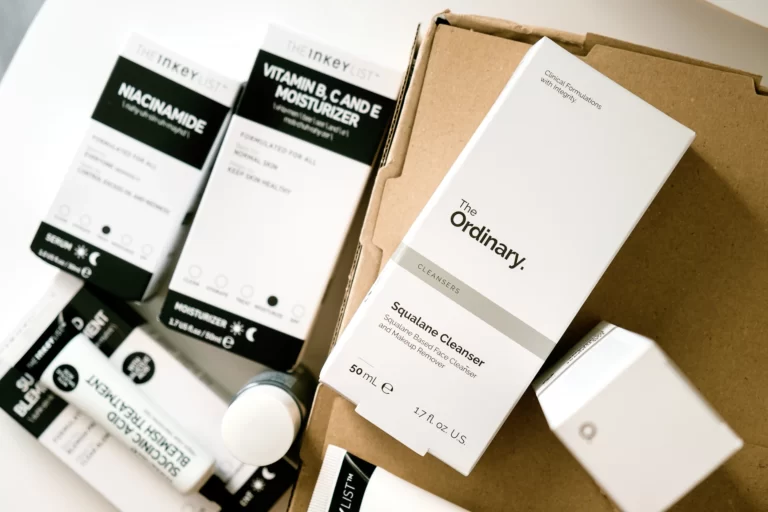A common question asked is, “Is it safe to mix azelaic acid with niacinamide?” when aiming to perfect one’s skincare regimen. The answer is a resounding yes! Merging these potent elements can provide numerous advantages for your skin and could potentially improve the effectiveness of each ingredient on its own.
Niacinamide and azelaic acid are both known for their ability to reduce redness, inflammation, and hyperpigmentation, providing a brighter complexion with consistent use. Together, they target common skin issues such as excess oil, acne, and post-acne marks, making them a desirable duo for many skincare enthusiasts.
Table of Contents
Can I Use Azelaic Acid with Niacinamide?
Great news if you’re wondering whether you can use azelaic acid with niacinamide – the answer is yes! In fact, combining these two ingredients may even increase their effectiveness, particularly in treating hyperpigmentation issues like dark marks, age spots, melasma, and post-inflammatory hyperpigmentation.
Both azelaic acid and niacinamide are powerful skincare ingredients that target and address similar skin concerns, but they do so through distinct mechanisms. Azelaic acid is a tyrosinase inhibitor, which means it blocks the enzyme tyrosinase responsible for melanin production. On the other hand, niacinamide is an effective UV blocker and helps prevent UV micro damage.
So, what happens when you combine these two ingredients? Several benefits arise from using azelaic acid and niacinamide together, including:
- Reducing redness and inflammation
- Brightening the skin and fading hyperpigmentation
- Enhancing the efficacy of each ingredient
✅ High quality
✅ Very effective
❌ May not be the perfect choice for people with rosacea
Not only are these two ingredients effective in tackling acne, hyperpigmentation, and inflammation when used together, but there are little to no side effects when layering these actives on top of one another. They can even help counteract potential dryness caused by chemical exfoliants, making them a powerful duo for promoting healthy, radiant skin.
But how exactly do you incorporate azelaic acid and niacinamide into your skincare routine? When using both ingredients, it’s essential to follow the product instructions and start with a lower concentration of each to minimize any potential irritation or sensitization. Applying niacinamide first followed by azelaic acid is a popular method among skincare enthusiasts.
What is Azelaic Acid?

Azelaic acid is a naturally occurring dicarboxylic acid found in barley, wheat, and rye grains. It is also produced by the skin’s microbiome, specifically the yeast Malassezia furfur. Azelaic acid has been widely used in the skincare industry due to its multiple benefits for various skin concerns, making it a popular ingredient in numerous products.
Having both anti-inflammatory and antimicrobial properties, azelaic acid is highly effective in treating acne and rosacea. It helps to unclog pores, reduces redness and inflammation, and prevents future breakouts. Furthermore, azelaic acid is a tyrosinase inhibitor, which means it targets the enzymes responsible for melanin production, ultimately leading to a reduction in hyperpigmentation and a more even skin tone.
Azelaic acid generally comes in various concentrations, ranging from 10% to 20% in prescription formulations and lower percentages in over-the-counter products. As it is suitable for all skin types, including sensitive skin, azelaic acid is considered to be relatively safe and well-tolerated by most individuals.
When incorporating azelaic acid into your skincare routine, it is important to remember that consistency is key. Since results may take a few weeks to become noticeable, it is essential to be patient and persistent with its use. Also, as with any skincare product, it is a good idea to perform a patch test before applying azelaic acid to your entire face to ensure that it suits your skin’s needs.
What is Niacinamide?

Niacinamide, or nicotinamide, is a water-soluble vitamin and a form of vitamin B3. It’s an essential nutrient that plays a vital role in maintaining overall skin health. It has become increasingly popular in skincare products due to its wide range of benefits, such as minimizing enlarged pores, brightening skin tone, and reducing wrinkles.
Not only does niacinamide help with the skin’s overall appearance, but it also plays a significant role in maintaining its health. This active ingredient is known to support the skin’s barrier function, which helps in retaining moisture and protecting the skin from environmental stressors. Additionally, it has powerful antioxidant properties, which neutralize free radicals that can cause premature aging and skin damage.
✅ Great quality
✅ Very effective
✅ Minimizes pores and wrinkles
❌ A bit pricy
Another notable benefit of niacinamide is its ability to reduce inflammation. This makes it particularly effective for people with acne-prone and sensitive skin. Furthermore, niacinamide can help regulate sebum production, reducing excess oil and minimizing breakouts.
Incorporating niacinamide into your skincare routine is relatively easy, as it is compatible with most skin types and other skincare ingredients. You can find it in serums, creams, and other skincare products at various concentrations, typically ranging from 2% to 10%.
Benefits of Using Azelaic Acid and Niacinamide Together
Combining niacinamide and azelaic acid in your skincare routine offers numerous benefits, as they enhance each other’s effectiveness without causing any negative side effects. In this section, we will explore the ways your skin may benefit from using these two potent ingredients together.
Firstly, both niacinamide and azelaic acid are known to reduce redness and inflammation. This makes them ideal for addressing skin issues such as post-inflammatory erythema, redness, and rosacea, leaving your skin looking calmer and more even-toned.
Another advantage of using these ingredients together is their ability to help with hyperpigmentation and uneven skin tone. Azelaic acid assists by halting new melanin production, while niacinamide prevents the already-existing melanin from altering skin cell color. The result is a brighter, more radiant complexion.
Furthermore, this powerful duo can also improve your skin’s texture. Azelaic acid is known for its ability to unclog pores and smoothen rough skin, while niacinamide promotes a healthy skin barrier. By using these ingredients together, you may experience softer, smoother skin with fewer visible pores.
Beyond these benefits, azelaic acid and niacinamide can also work together to combat acne and early aging signs. Both ingredients have an impact on acne by reducing inflammation and tackling hyperpigmentation. Additionally, niacinamide can help to minimize fine lines and wrinkles, promoting a youthful appearance.
In conclusion, incorporating both azelaic acid and niacinamide into your skincare routine can provide numerous advantages. From reducing redness to improving texture and combating acne, this combination may greatly enhance your skin’s overall health and appearance.
Potential Side Effects and Precautions

While using azelaic acid and niacinamide together can offer several benefits for your skin, it is essential to be aware of potential side effects and precautions. As with any skincare product, individual reactions may vary.
Azelaic acid may cause some common side effects such as skin burning, dryness, and peeling. It is important to monitor your skin’s response when using azelaic acid products and adjust the frequency of application accordingly.
Niacinamide, on the other hand, is generally well-tolerated, but some individuals still may experience adverse effects. These can include mild redness, itching, or irritation, particularly in those with sensitive skin.
To minimize potential side effects, follow these precautions:
- Perform a patch test: Before incorporating a new product containing azelaic acid or niacinamide, test it on a small part of your skin to ensure you do not experience an allergic reaction.
- Start with a lower concentration: Begin with products containing lower concentrations of azelaic acid and niacinamide to allow your skin to acclimate. Gradually increase the concentration if desired and if no adverse effects occur.
- Avoid over-exfoliation: Combining azelaic acid with other exfoliants may increase the risk of skin irritation. Ensure you balance exfoliation and hydration in your skincare routine.
- Consult a dermatologist: If you’re unsure whether azelaic acid or niacinamide is suitable for your skin type or concern, consult a dermatologist for personalized advice.
Incorporate Azelaic Acid and Niacinamide in Your Skincare Routine

Combining azelaic acid with niacinamide can offer numerous benefits for your skin, such as reducing inflammation, brightening your complexion, and improving your skin’s overall health. Here’s a straightforward guide on incorporating both ingredients into your skincare regimen.
First and foremost, it’s essential to patch-test both products on your arm or wrist 24 hours before applying them to your face. This helps to prevent unexpected adverse reactions or irritation. According to Apostrophe, it is recommended to start by using azelaic acid a few times a week, once a day.
Once you determine that your skin can tolerate both ingredients, follow these guidelines for seamless integration:
- Cleanse your skin: Start with a gentle cleanser to remove dirt and oil, setting the stage for the active ingredients.
- Apply niacinamide: After cleansing, apply a niacinamide serum to your face. Allow it to absorb fully for a minute or two.
- Apply azelaic acid: Next, apply a pea-sized amount of azelaic acid over your face. As Nordstrom suggests, you should use azelaic acid after cleansing, starting with just a few times a week and working your way up to daily use if tolerated well.
- Moisturize: Follow up with a hydrating moisturizer to lock in the active ingredients and keep your skin nourished.
- Sunscreen: In the morning, don’t forget to apply an SPF 30 or higher sunscreen to protect your skin from UV damage.
Remember: Consistency is critical, as incorporating both azelaic acid and niacinamide into your routine may take some time to reveal noticeable results. Be patient, and monitor your skin closely for positive changes or signs of irritation.
For an even more personalized routine, consider consulting with a dermatologist or skincare professional to assess your specific needs and recommend a suitable schedule for using both ingredients.
Common Myths about Azelaic Acid and Niacinamide
In my skincare journey, I’ve encountered several misconceptions and myths surrounding the use of azelaic acid and niacinamide together. Let’s debunk these and set the record straight:
1. Myth: Azelaic Acid and Niacinamide Cancel Each Other Out: Contrary to this belief, these ingredients can complement each other. They address different skincare concerns and work together harmoniously.
2. Myth: The Combination Causes Irritation: While it’s essential to be cautious when combining skincare products, many people can use azelaic acid and niacinamide together without irritation. Start slowly, and listen to your skin’s response.
3. Myth: They Cannot Be Used in the Same Routine: It’s perfectly fine to use azelaic acid and niacinamide in the same skincare routine. Layer niacinamide first, followed by azelaic acid for optimal results.
4. Myth: You’ll See Instant Results: Skincare takes time. Don’t expect overnight miracles. Consistent use over weeks or even months is often required to see significant improvements.
5. Myth: It’s a One-Size-Fits-All Approach: Everyone’s skin is unique. What works for one person may not work for another. Customizing your skincare routine and seeking expert advice can make a big difference.
Pro Tip: If you’re concerned about potential interactions, consider using products that already combine azelaic acid and niacinamide. These are formulated to ensure compatibility.
By dispelling these misconceptions and embracing the potential of azelaic acid and niacinamide, you can harness their benefits effectively in your skincare routine. Remember, patience and consistency are key to achieving your skin goals.
FAQ:

How do you combine niacinamide and azelaic acid?
You can combine niacinamide and azelaic acid in the same skincare routine to help brighten the skin, reduce inflammation, and improve skin barrier. Layer them according to their thickness and consistency.
What should you not mix with azelaic acid?
Avoid using azelaic acid with other acids, such as AHAs, BHAs, and vitamin C, as they can cause irritation and compromise the skin barrier. Also, avoid using it with retinol, benzoyl peroxide, and high concentrations of niacinamide.
Can azelaic acid The Ordinary use with niacinamide?
Yes, The Ordinary Azelaic Acid Suspension 10% can be used with The Ordinary Niacinamide 10% + Zinc 1% in the same skincare routine to help brighten the skin, reduce inflammation, and improve skin barrier.
Is azelaic acid and niacinamide a good combination?
Yes, azelaic acid and niacinamide are a good combination as they work together to reduce inflammation, brighten skin, and improve skin barrier function. Both ingredients are well-tolerated and suitable for most skin types.
What should you not mix with niacinamide?
Avoid mixing niacinamide with vitamin C, AHAs, BHAs, or retinol, as they can reduce the effectiveness of niacinamide or cause irritation. Also, avoid using high concentrations of niacinamide with benzoyl peroxide.
Can I layer vitamin C niacinamide and azelaic acid?
Yes, you can layer vitamin C, niacinamide, and azelaic acid in the same skincare routine. Apply vitamin C first, wait a few minutes, then apply niacinamide, and finally, apply azelaic acid. However, some people may experience irritation, so patch test first.
Do you use niacinamide first or azelaic acid?
Apply niacinamide before azelaic acid in your skincare routine. Niacinamide has a lighter texture and is easily absorbed by the skin, while azelaic acid has a thicker texture and may be less effective if applied first. Wait a few minutes between applications.
Do you use azelaic acid before or after serums?
Apply azelaic acid after your serums in your skincare routine. Azelaic acid has a thicker texture and needs to be applied after lighter, water-based serums. Wait a few minutes between applications to allow each product to fully absorb into the skin.
What is the best routine with azelaic acid?
The best routine with azelaic acid is to use it after cleansing and toning, followed by lighter serums, then moisturizer and sunscreen. Use it once or twice a day, depending on your skin’s tolerance. Avoid using it with other acids or retinoids.
What serums can I use with azelaic acid?
You can use water-based serums with azelaic acid, such as hyaluronic acid, niacinamide, and vitamin C. Avoid using other acids or retinoids with azelaic acid, as they can cause irritation.
If you liked this blog article: Can I Use Azelaic Acid with Niacinamide, don’t forget to leave us a comment down below to tell us about your experience.







